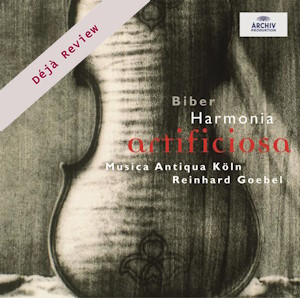
Déjà Review: this review was first published in March 2005 and the recording is still available.
Heinrich Ignaz Franz von Biber (1644-1704)
Harmonia artificioso-ariosa: diversi mode accordata (1712)
Musica Antiqua Köln/Reinhard Goebel (violin)
Partia I for two violins and b.c. in d minor
Partia II for 2 violini piccoli and b.c. in b minor
Partia III for two violins and b.c. in A
Partia IV for violin, viola and b.c. in E flat
Partia V for two violins and b.c. in g minor
Partia VI for two violins and b.c. in D
Partia VII for two viole d’amore and b.c. in c minor
rec. 2003, Studio of Deutschlandfunk, Cologne, Germany
Archiv Produktion 4749652 [2 CDs: 98]
The English music historian and critic Charles Burney referred to Biber as late as 1789 thus: “Of all the violin players of the last century Biber seems to have been the best, and his solos are the most difficult and most fanciful of any music I have seen of the same period”.
Biber was a celebrity, not only in his own time, but also among later generations of composers. In the liner notes to the present recording Goebel mentions a quartet by Telemann which quotes a passage from one of the Partias from this collection. He believes that Johann Sebastian Bach must have known at least some of Biber’s music as well.
Virtuosity is one of the main characteristics of Biber. But his famous ‘Mystery Sonatas’ are ample evidence that his music delivers much more than that. And so do the seven Partias which comprise the collection ‘Harmonia artificioso-ariosa’, which was published posthumously in 1712.
Many of the movements here are highly dramatic. Good examples are some of the praeludia. The prelude is often a way to set the mood, and to explore the key in which the piece is written. The ‘praeludia’ of the Partias VI and VII are both in two sections, the first slow, the second fast, creating a very strong and dramatic contrast and working towards an exciting climax. The same thing often happens in forms like passacaglia (Partia V) and ciacona (Partia III).
In particular the variations which appear in all Partias, except Partia IV, confront the listener with a whole catalogue of playing techniques, for example long slurs of demisemiquavers which are to be played staccato (Partia VI).
This sixth Partia is the only ‘conventional’ one as far as the tuning is concerned. In all other Partias Biber makes use of the ‘scordatura’ technique, which means that the strings of the violin are tuned to notes appropriate to the key of the piece. It seems this technique finds its origin in the tuning practices on the lyra viol in England in the first half of the 17th century. It is interesting to note that Biber was a viol player himself, and that English viol music was well known in Austria in his time, perhaps partly due to the presence of the English viol player William Young in Innsbruck.
This collection is also interesting in regard to instrumentation. Partia IV is set for violin and viola, which is rather uncommon: when violas were used in the Austro-German region it was mostly in a pair within a five-part texture. The other Partia with an unconventional instrumentation is the seventh, which is for two viole d’amore.
Reinhard Goebel has been fascinated with Biber’s music during his whole life. For a long time he has struggled to get a grip on these particular pieces. He recorded the ‘Mystery Sonatas’ in 1990, but only in 2004, the tercentenary of Biber’s death, did he record these Partias. As he writes in the booklet it is essential to have two violinists who are technically at the same level, as both violin parts are absolutely equal. In Stephan Schardt he has a player at his side who is his equal in every respect. Listening to this disc it is impossible to tell them apart. It is disappointing that only in the last Partia the basso continuo is played by the harpsichord only, although Goebel admits that “whereas it is now usual to employ double continuo in 18th-century music, this doubling is by no means historically justified”. I must say that I strongly prefer the performance with a harpsichord only, without an additional cello. I sometimes find the cello here a little obtrusive, and the use of vibrato by the cellist is at times a little too extensive.
On the whole these performances do full justice to both the virtuosic and the dramatic character of the music. Often the performance is outright exciting. The quite improvisatory character of the ‘praeludia’ is very well realised and the players are fully aware of the contrasts in tempo and dynamics, as one can hear in the ‘Sonatae’ which open the Partias I and IV, and which both contain a sequence of slow-fast-slow. One could argue, though, that this performance is perhaps a little too ponderous. In particular in the ‘balletti’ (Partias II and V) I would have liked to hear a little relaxation. But this is a feature of Musica Antiqua Köln’s style of playing: very serious and profound. For music from this period and this region this seems to me to be the right approach, but in this recording it is exaggerated sometimes. More breathing space here and there would have been appropriate.
That said, this recording is an outstanding achievement, which I strongly recommend. It will be very difficult to find a performance which better and more convincingly explores the content of these brilliant compositions.
Johan van Veen
Help us financially by purchasing from


















